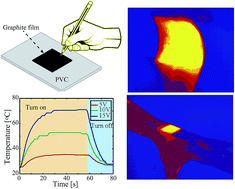Flexible and multifunctional electronics fabricated by a solvent-free and user-friendly method†
Abstract
Flexible and multifunctional electronic devices have been proven to show potential for various applications including human-motion detection and wearable thermal therapy. The key advantages of these systems are (1) highly stable, sensitive and fast-response devices, (2) fabrication of macroscale devices on flexible substrates, and (3) integrated (lab-on-chip) and multifunctional devices. However, their fabrication commonly requires toxic solvents, as well as time-consuming and complex processes. Here, we demonstrate the low-cost, rapid-prototyping and user-friendly fabrication of flexible transducers using recyclable, water-resistant poly(vinyl chloride) films as a substrate, and ubiquitously available pencil graphite as a functional layer without using any toxic solvents or additional catalysts. The flexible heaters showed good characteristics such as fast thermal response, good thermostability (low temperature coefficient of resistance) and low power consumption. The heaters with their capability of perceiving human motion were shown to be effective. The proof of concept of other functional devices such as vibration-based droplet sensors and drag-force air flow sensors was also demonstrated. Results from this study indicate that a wide range of electronic devices fabricated from the environmental-friendly material by this simple and user-friendly approach could be utilized for cost-effective, flexible and low power consuming thermal therapy, health monitoring systems and other real-time monitoring devices without using any toxic chemicals or advanced processes.



 Please wait while we load your content...
Please wait while we load your content...